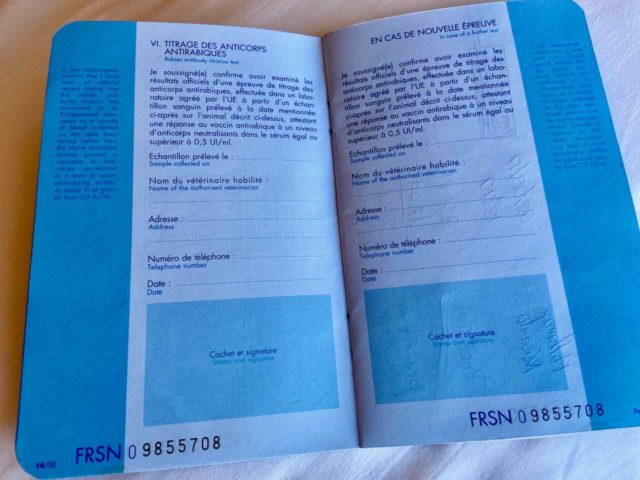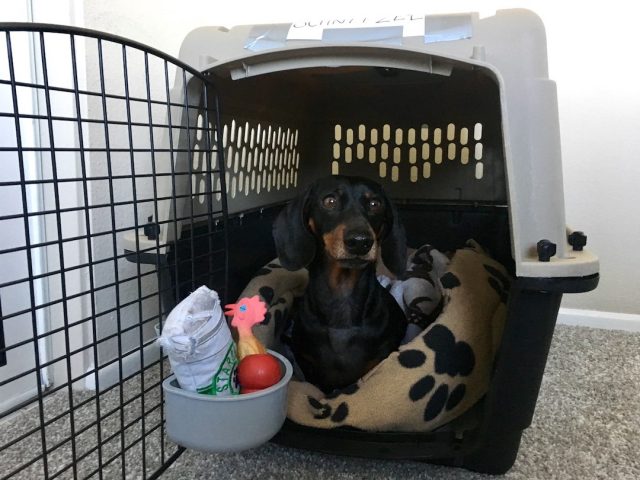Importing a dog to Australia is a long and difficult process, with a long list of preparation steps, tests and treatments, not to mention a stay in quarantine for nearly all pets. During March 2023, changes were made to the process, making it even more difficult.
I’ve previously written about my experience bringing my dog to Australia after travelling overseas, but these are some tips for anyone planning on importing dogs to Australia, including tips on the latest import requirements.

#1 Determine if You Can Import Your Pet
Before starting the process to import a dog to Australia, firstly check that you can indeed import your pet. There are a number of breeds of pet dogs that it is prohibited to import to Australia.
The following breeds of dog are prohibited from being imported to Australia:
- Dogo Argentino
- Fila Brasileiro
- Japanese Tosa
- American pit bull terrier or pit bull terrier
- Perro de Presa Canario or Presa Canario
Additionally, it is not permitted to import domestic/non-domestic animal hybrids, including the following:
- Czechoslovakian wolfdog or Czechoslovakian Vlcak
- Saarloos wolfdog or Saarloos wolfhound
- Lupo Italiano or Italian wolfdog
- Kunming wolfdog or Kunming dog
For cats, the following hybrid cats are also not eligible to be imported:
- Savannah cat, derived from crossbreeding domestic cat (Felis catus) with Serval cat (Felis serval)
- Safari cat, domestic cat crossed with Geoffroy cat (Oncifelis geoffroyi)
- Chausie, domestic cat crossed with Jungle cat (Felis chaus)
- Bengal cat, domestic cat crossed with Asian Leopard cat (Prionailurus bengalensis) (except in limited cases)
#2 Find Out if Your Country is Approved
The other main potential barrier to importing pets to Australia is whether you country is on the list of approved countries, from which it is possible to import a dog or cat to Australia.
To find out whether you country is on the list of approved countries to import dogs to Australia, see the lists on this page, split into Group 1, Group 2 and Group 3 countries (each with slightly different import processes).
Note that sometimes territories of a country or specific states are listed separately, e.g. there is a different process to import pets from Hawaii compared to from the rest of the United States.
If your country is not listed, it is an unapproved country. Since March 2023, it is no longer possible to import a dog or cat that has resided in non-approved countries during the 180 days prior to dog export to Australia.
You must firstly move your pet from their country of origin to a Group 2 or Group 3 approved country and then start the process.

#3 Allow Plenty of Time
The entire process for importing pets to Australia is a long one. It takes roughly seven months to prepare a dog or cat for export to Australia.
The longest period of time is the waiting period after your pet undergoes a rabies titre test (also called a rabies neutralising antibody titre test or RNAT test).
There is a mandatory waiting period of 180 days after the blood sample arrives at the lab for the RNAT test that results in a successful result before your pet can be exported to Australia.
If you also need to have your pet vaccinated for rabies beforehand, particularly for the first time, it is also recommended you wait for 3-4 weeks after the rabies vaccination before the blood sample is taken for the RNAT test. Hence, the potential timeframe of seven months.
Even for pets being exported from a Group 2 country that do not require a rabies titer test, the new identity verification step (see below) needs to be done at least 180 days prior to export.

#4 Be Aware Pet Quarantine is Required
Australia is one of the few countries in the world that requires quarantine for nearly all pets that arrive in the country.
Unless you are currently in New Zealand (or the Australian territories of Norfolk Island or Cocos (Keeling) Islands), all pets must undergo quarantine. There is no other way to avoid pet quarantine in Australia.

Up until recently, the minimum quarantine period in Australia was 10 days for all pets. (Although in the past this was longer, sometimes months long.) However, in March 2023, the minimum quarantine period was increased to 30 days for some cases.
For pets being imported to Australia from Group 3 countries (including the United States, United Kingdom, most of Europe, United Arab Emirates, South Korea and Hong Kong), unless a new identity verification step (see below) is performed, a minimum Australian quarantine period of 30 days applies instead of 10 days – a far longer stay!
There is only one pet quarantine facility in Australia, the Mickleham post entry quarantine facility in Melbourne. Generally, visits haven’t been permitted to pets in quarantine, at least if the 10 day period applied. However, visits may be possible if your pet is facing a longer stay.
Find out more about the dog quarantine facility in Australia, including my experience having my dog stay in quarantine.
#5 The New Identity Verification Step
In March 2023, a new identity verification step was introduced for pets being exported to Australia.
Your pet must be presented to an official government veterinarian directly employed by the competent authority in your country of export for verification.
This new step is required for all pets being exported from a Group 2 country, at least 180 days prior to export.
For pets being exported from a Group 3 country, this is required for pets to be eligible for a quarantine stay of only 10 days, instead of 30 days, unless the pet originated from Australia (in which case their export certificate can be used). This needs to be done before the RNAT test.
In the first couple of months of the step being introduced, there were issues with the step being performed in some countries. In some countries, it may still not be possible to do this, resulting in no option but a 30 day minimum stay in quarantine.
Note that in the United States, an alternative verification process involving two accredited veterarians has been set up and approved. See the detailed instructions on the USDA website.
#6 Expiration of Rabies Titre Test
Note that the RNAT test required for the import of a dog or cat to Australia from a Group 3 country has an expiration date.
This is very different to the situation of importing a pet to the EU, where the RNAT test result remains valid as long as your dog continues to receive rabies booster shots before the previous vaccination expires.

Previously, the expiration period was two years. However, since March 2023, the expiration period for a RNAT for import to Australia has been shortened to one year (365 days).
This is quite a short period of time considering that you need to wait until at least 180 days after the blood was received by the testing laboratory for it to be valid – meaning it is only valid for a short six month window!
#7 Consider Using a Pet Transport Company
There is no requirement to use a pet transport company to import your pet to Australia, although many airlines require this, to book pets onboard their flights to Australia.
When returning home to Australia with my dog from the United States, I skipped using a pet transport company, as at the time I could book the my dog directly with Qantas Freight (on a direct flight from Los Angles to Melbourne), plus I was already familiar with the import process for other countries.
However, pet transport to Australia is a very difficult and stressful process to do by yourself, and I recommend that you consider using a pet transport company.

Ideally you should use a pet transport company that is experienced at flying pets to Australia, who is already familiar with the process and timeline.
Another advantage of using a pet transport company is if something goes wrong. Despite the best preparations, your pet may fail one of the blood tests or their flight may be cancelled.
Particularly if you’re also about to fly to Australia, a pet transport company is better placed to organise a kennel and their eventual departure.
#8 Be Aware of Costs
The total cost to export a dog to Australia is quite substantial. In addition to the actual flight cost, there is also the cost of vet appointments, certificates, the import permit for Australia and the stay in quarantine.
For a summary of the costs involved, including what I paid to import my pet to Australia and the latest government costs, see my guide to the cost to bring a dog to Australia.

Costs have increased in recent years. As a start pointing, expect to pay at least $5000 to $10,000 USD to import a single pet. This is flying cargo, with larger dogs costing more than smaller dogs. Chartered flights are substantially more expensive.
If using a pet transport company, many of the costs will be bundled together, including their overhead.
#9 Find a Vet Familiar with the Process
As part of the process to import a dog to Australia, you’ll need to visit a vet multiple times in the lead up, for the different tests, internal and external parasite treatment and the final examination and veterinary health certificate. They will need to be a government-approved veterinarian (a USDA accredited veterinarian in the USA).
(Note that the process for cats is slightly simpler, with no tests required other than the RNAT test.)
It will be a lot easier if you find a vet who is already familiar with the import process for Australia, regardless of whether this is organised by your pet transport company or you directly engage with a vet.

#10 Double Check Dates
One of the trickiest parts of the import process is getting the timeline right. There are a lot of different steps, with different date requirements.
For instance, dogs and cats being transported to Australia need to received two internal parasite treatments, within 45 days of export, at least 14 days apart, with the second treatment within five days before export. And the dates must be correct – they will be checked!
This is part of the reason why it is good to work with a veterinarian who is already familiar with the Australian import process, or with a pet transport company who will organise these steps for you.
#11 Ehrlichia Canis Testing Not Required
Previously, one of the tests required for dogs being imported to Australia was a blood test for Ehrlichia canis, a tick-borne parasite that causes the disease Ehrlichiosis.
Since 2020, this disease has become established in Australia, predominantly in the Northern Territory, northern Western Australia and northern South Australia. (If travelling to these areas with your dog, take precautions to keep your dog safe from ticks.)

Since November 2022, the requirement for your dog to test negative to Ehrlichia canis has been removed. If your dog previously tested positive and was prevented from coming to Australia, they are now able to be imported to Australia.
#12 Allow Time for Import Permits and Quarantine Bookings
During 2023, I’ve heard reports that import permits are taking quite a while to be approved and the post-entry quarantine facility is booked out for months in advance.
Be aware of this, and complete these steps well in advance – ideally as soon as possible after completing the RNAT test and declaration for your dog. The import permit application can only be done after the RNAT declaration step is complete, and a quarantine booking requires a valid import permit.
On the step by step guide, it is listed that the import permit needs to be applied for at least 42 days before the proposed date of export, but this is nowhere near sufficient!
This is quite different to when I travelled to Australia with my dog in 2018. I had my import permit approved promptly. I then had to follow up my quarantine booking request, made about 3 1/2 months in advance, as my booking was done so early!
The current situation is likely due to the changing requirements and many pets now requiring 30 days Australian quarantine, so may settled down in 2024.
#13 Investigate Export Certificates
In addition to the import permits and certificates required for Australia, some countries also require your dog to have an export certificate completed before your dog leaves the country.
I didn’t need to complete this step when flying my dog from the USA back to Australia. The same applies for dogs flying out of most European countries. However, my dog required an export certificate when flying out of Australia in the first place.
Double check with your local government authorities. Usually this can be completed at the same time at the other steps at the government approved veterinarian and official government veterinarian.
#14 Crate Train Your Dog
Unfortunately, it’s not possible to fly your dog in the cabin to Australia on a commercial flight, even if your pet is normally small enough to do this and the airline normally allows this.
According to the Australian government website, “your cat or dog must travel to Australia as manifest cargo”, specifically to Melbourne Airport. The one exception is on private jets, a very expensive alternative, so most dogs flying to Australia fly as cargo.
Pets flying as cargo in the hold of a plane need to fly in an International Air Transport Association (IATA) approved crate. Ideally try to purchase one as soon as possible, or your pet transport company may supply one as part of their service.

Even if you don’t have the final crate initially, start crate training your pet as soon as possible, if they are not already crate trained. Your dog will be a lot more relaxed on their long flight to Australia if they are happy at being in their crate.
Tips for crate training your dog include feeding your dog treats and meals in their crate, putting their toys in the crate and encouraging them to sleep in their crate. Only use positive reinforcement, don’t punish your dog as part of training.
#15 Reconsider a Short Holiday
It doesn’t need repeating that importing a dog to Australia is a long and difficult process, not to mention the cost involved. This isn’t something that you should go through if you’re just planning on visiting Australia on a short holiday.

The majority of dogs that are imported to Australia and go through this process are permanently relocating. Alternatively, if you’re visiting Australia for a fairly long period, such as a year or two, consider going through the import process. However, if you’re just visiting Australia on a short holiday, it’s better to find someone to look after your dog at home.
The difficulty in returning to Australia with a dog should also be taken into consideration if you currently live in Australia and plan on heading overseas with your dog. You’ll also need to go through this process on your return, so carefully consider whether you should take your dog overseas.
#16 Try to Relax!
Finally, try to relax and don’t stress too much about the process. The steps to import a dog to Australia are long and difficult, but the majority of dog owners successfully navigate the process, maybe with one or two small hiccups that can be overcome.
You can reduce the burden on yourself by using a pet transport company (and paying a little more) or finding a vet who is familiar with the process. Plus reach out to other people in the same situation, such as in Facebook groups.

Some pet owners worry about worse case scenarios, such as their pet being euthanised. This is an extraordinary situation, that I have never heard happen to anyone.
All the pet owners I know have been happily reunited with their pets at the end of their minimum stay in quarantine, ready for new adventures together in Australia.
You May Also Like
- Bringing a Dog to Australia: My Experience
- How Much Does It Cost to Bring a Dog to Australia?
- Complete Guide to Dog Quarantine in Australia
- Is There a Way to Avoid Pet Quarantine in Australia?
- How to Take Your Dog Overseas from Australia
About the Author

Shandos Cleaver is the founder of Travelnuity: Dog-Friendly Travel. She has travelled extensively with her Miniature Dachshund, Schnitzel, including to 33 countries across Europe, every state and territory of Australia except Tasmania, and 10 of the United States. She’s passionate about providing inspiration and information to others wanting to travel with their dogs, whether close to home or internationally.
